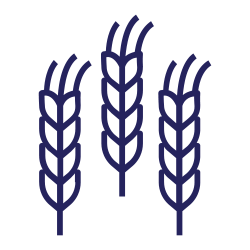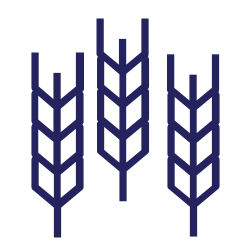Section Title
Plant Growth Regulator (PGR) Options for Barley
Crop Types
By Alberta Barley, Saskatchewan Barley Development Commission and the Manitoba Crop Alliance

Growers now have two plant growth regulator (PGR) options to mitigate lodging risk in barley. Both Manipulator and Moddus are registered for use on barley in Canada. However, growers may be asking what is the right choice for their farm?
Manipulator (chlormequat chloride) was first available to barley growers in 2020. Moddus (trinexepac-ethyl) is available for the first time in 2021. Researchers have been working with both products to evaluate response.
The scientific literature, from Western Canadian and international studies, favours the use of Moddus on barley (Figure 1). An international review paper by Rademacher (2015) states “barley is less responsive to chlormequat chloride [the active ingredient in Manipulator] and mepiqat chloride than wheat, rye, triticale, or oats. Therefore, products containing trinexapac-ethyl [the active ingredient in Moddus], prohexadione-calcium, or the ethylene releasing ethephon are preferentially used to reduce the risk of lodging in this species.”
Western Canadian research with PGRs on CDC Copeland barley, at five locations over three years, also found that trinexapac-ethyl [Moddus] showed the largest number of lodging reductions (Tidemann, et al., 2020). The scale of reductions seen with trinexapac-ethyl [Moddus] shows the most promise for application on barley. These studies tested PGR applications between Zadoks growth stage (GS) 30–33 for chlormequat chloride and trinexapac-ethyl and GS 37–49 for ethephon.
Some Alberta research was conducted in 2018 at Barrhead, St. Albert and Vermilion on AAC Synergy and CDC Copeland barley (Strydhorst et al., 2019). Manipulator and Moddus were applied at label rates at GS 31-32 (Figure 2). Manipulator reduced plant height by an average of 3 cm and Moddus reduced plant height by an average of 10 cm. There was minimal lodging; however, CDC Copeland had slight lodging at Barrhead. At that site, Moddus significantly improved standability compared to the untreated control. There was no significant improvement in standability in barley treated with Manipulator relative to the untreated control.
PGRs are meant to mitigate lodging risk in highly productive environments where agronomic inputs target high yields, or where genetic resistance to lodging is inadequate. These scenarios typically lead to higher lodging risk. However, this does not mean PGRs are required on these farms every year. If environmental conditions are not favourable for lodging (i.e. drought), PGRs should not be used. The Moddus label states “Due to risk of injury to barley, avoid overlapping application and do not apply to barley that is environmentally stressed”. The Manipulator label states “DO NOT apply Manipulator 620 to crops under stress from waterlogging, drought or nutrient deficiency”. In these situations, no PGR application is best.
The Manipulator 620 label indicates it is “for treatment of spring, durum and winter wheat, spring and winter barley, and spring and winter oats to manipulate apical dominance and producer shorter, thicker, stronger stems for improved lodging resistance.” Manipulator contains the active ingredient chlormequat chloride.
The Moddus label indicates it “will aid in the growth and lodging management of wheat, barley, and oats.” Moddus contains the active ingredient trinexapac-ethyl.
It should also be noted that the Ethrel PGR label does NOT include barley.
In summary, to ensure the most value from your PGR application, consider both environmental conditions and select the most appropriate product for the intended crop. In the case of barley, Moddus has shown to have better efficacy in reducing heights and improving standability.
Please follow all label directions for the application of plant growth regulators.

Figure 1. Gadsby barley grown at Barrhead, AB on August 8, 2016. Left: Chlormequat chloride (the active ingredient in Manipulator). Right: Trinexapac-ethyl (the active ingredient in Moddus). PGR treatments were applied at GS 31-32.
Please note that this article and these images do not reflect the performance of Manipulator in wheat. Manipulator has shown excellent performance in wheat, but in wheat it is still important to remember that PGRs should not be used when the crop is under stress.

Figure 2. Growth stage 31-32, ideal application timing for Manipulator and Moddus PGR.
- The Growing Point Podcast - PGRs on Barley: Which Option is Preferred?
- Download: Plant Growth Regulator (PGR) Options for Barley (pdf)
For more information on PGRs, contact our provincial representatives at the following coordinates:
Alberta
Sheri Strydhorst, M.Sc., PhD.
Alberta Wheat & Barley Commissions
sstrydhorst@albertawheatbarley.com
Saskatchewan
Mitchell Japp, M.Sc., P.Ag.
SaskBarley Development Commission
mjapp@saskbarleycommission.com
Manitoba
Mallorie Lewarne
Manitoba Crop Alliance
mallorie@mbcropalliance.ca
References
- Bayer Crop Science Inc. 2021. Ethrel Liquid Plant Growth Regulator. Accessed 3 May 2021. Available at: https://www.cropscience.bayer.ca/-/media/Bayer-CropScience/Country-Canada-Internet/Products/Ethrel/Ethrel-Label---English-02_04_21_ac.ashx?la=en&hash=AEA622831836B3FFAED1E9F342D859D295067681
- Belchim Crop Protection Canada. 2020. ManipulatorTM 620. Accessed 3 May 2021. Available at:https://www.belchimcanada.com/Label/59/E/1.pdf
- Syngenta. 2020. Moddus®. Accessed 3 May 2021. Available at: https://assets.syngenta.ca/pdf/ca/labels/Moddus_33930_en_pamphlet.pdf
- Rademacher, W. 2015. Plant Growth Regulators: Backgrounds and Uses in Plant Production. J. Plant Growth Regul. 34:845-872.
- Strydhorst, S., Hall, L.M., Thompson, L. 2019. Plant Growth Regulators for Cereal Crops. Final Report to the Alberta Funding Consortium for project RES0041117 – AF819487.
- Tidemann, B.D., O’Donovon, J.T., Izydorczyk, M., Turkington, T.K., Oatway, L., Beres, B., Mohr, R., May, W.E., Harker, K.N., Johnson, E.N., and de Gooijer, H. 2020. Effects of plant growth regulator applications on malting barley in western Canada. Can. J. Plant Sci. 100:653-665.








